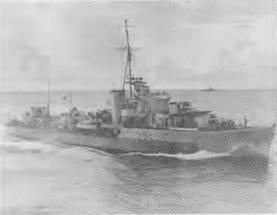- Author
- Law, George B.
- Subjects
- Naval technology, History - WW2
- Tags
-
- RAN Ships
- HMAS Nepal
- Publication
- April 1993 edition of the Naval Historical Review (all rights reserved)

Some former “N” Class matelots may remember the additional bit of structural hardware, shaped like a bird-cage, on top of a mast above the four inch gun on the NEPAL and perhaps may have wondered just what it was all about. If the readers will bear with me for a while as I reminisce back to those first few months in the Royal Navy I may then have explained the bird-cage, or I should say High Frequency Direction Finding or HFDF for short.
I started off Navy days with a six months stretch at HMS Royal Arthur, a peacetime Butlin’s Holiday Camp, at Skegness on the east coast, where I was trained in telegraphy. Incidentally, it was winter time (November 1941 to April 1942) and pneumonia took its toll on trainees at that time – in a holiday camp inadequately equipped for English winter conditions. Having completed the training I was despatched to Portsmouth to await drafting instructions and one day as we practised Morse Code exercises a Chief Petty Officer came around asking if anyone would like to have a two-week holiday at Scarborough (a top sea-side resort not far from my home town, Hull). So, abandoning all the advice I had been given earlier (never volunteer for anything) I was soon on my way to join this mystery trip to Scarborough where I met others who had also taken up the offer. The hotel where we stayed compared very favourably with Pompey barracks and it all seemed to be very promising even though somewhat mystifying.
The mystery continued on the first morning as we left the hotel in a coach, windows all blacked out, heading for a village about ten miles away. It was there, in a secluded old building, where we learned all about German wireless telegraphy and communication systems operating between German and German-occupied shore stations, and submarines and surface craft in the Atlantic and elsewhere. Maintenance of WT silence was just as important with the Germans as the Allies but occasionally the silence was broken and U-boats transmitted short urgent signals to the controlling shore station. We learned that when a U-boat was shadowing a ship or convoy a series of “E Bars” (di di dah dah di di) would be transmitted, and when an attack was about to be made, the signal would be “B bars” (dah di di di dah). It was all very interesting but the purpose of the training became clear only when we learned how, with HFDF, it was possible to obtain a bearing on the U-boat. Of course speed was paramount as the signals were brief and had to be identified amid all the signals from the shore station transmitting on the same frequency. The training included some practical work, tuning in to the Lorient, in occupied France, the shore station controlling U-boats in the Western Approaches – and sure enough signals other than from the shore station were identified. The training continued with the use of a goniometer, an instrument with a 360 degrees face and a manual rotating device used to determine the strength of the signals. A zero reading of a signal would indicate the direction from which the transmission was made and the nearness of the transmitter could be assessed by the width of the zero reading – the narrower the nearer. There was another important element, however, that is the metal structure of the ship, which had the effect of distorting the direction of the zero reading. Having taken a reading it was necessary to amend in accordance with pre-determined calibration tables related to particular radio frequencies. The most effective use of HFDF was achieved with two or more units obtaining bearings from varying positions, thus providing a pretty accurate fix on the marauding unit. In this way HFDF played a large part in locating U-boats in the North Atlantic during those very critical war years when enormous volumes of supplies and equipment were shipped across from America and Canada.
Hopefully, the readers may now have a rough idea of what HFDF was all about but perhaps these jottings beg more questions than they answer and what about the birdcage down aft? – well that was the special aerial designed to receive the high frequency transmissions.
